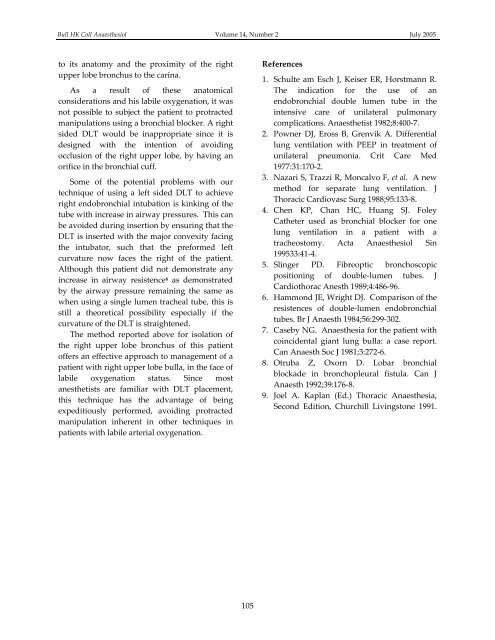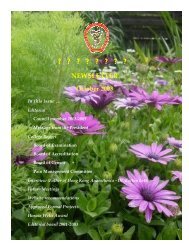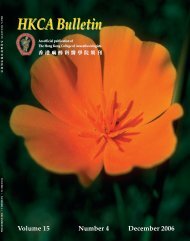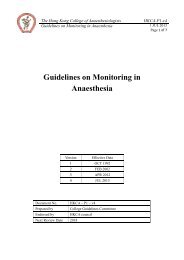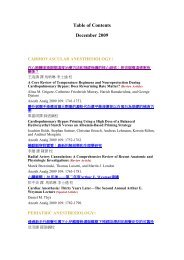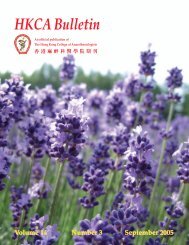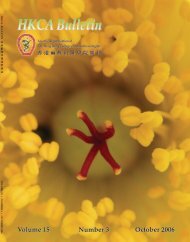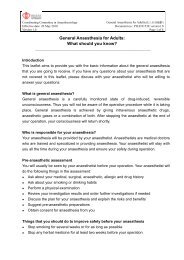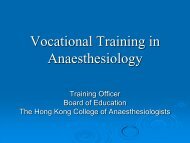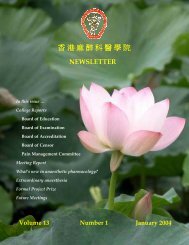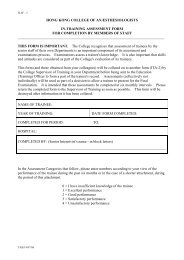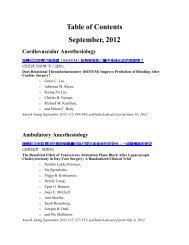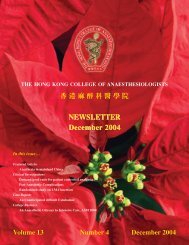July 2005 - The Hong Kong College of Anaesthesiologists
July 2005 - The Hong Kong College of Anaesthesiologists
July 2005 - The Hong Kong College of Anaesthesiologists
Create successful ePaper yourself
Turn your PDF publications into a flip-book with our unique Google optimized e-Paper software.
Bull HK Coll Anaesthesiol Volume 14, Number 2 <strong>July</strong> <strong>2005</strong>to its anatomy and the proximity <strong>of</strong> the rightupper lobe bronchus to the carina.As a result <strong>of</strong> these anatomicalconsiderations and his labile oxygenation, it wasnot possible to subject the patient to protractedmanipulations using a bronchial blocker. A rightsided DLT would be inappropriate since it isdesigned with the intention <strong>of</strong> avoidingocclusion <strong>of</strong> the right upper lobe, by having anorifice in the bronchial cuff.Some <strong>of</strong> the potential problems with ourtechnique <strong>of</strong> using a left sided DLT to achieveright endobronchial intubation is kinking <strong>of</strong> thetube with increase in airway pressures. This canbe avoided during insertion by ensuring that theDLT is inserted with the major convexity facingthe intubator, such that the preformed leftcurvature now faces the right <strong>of</strong> the patient.Although this patient did not demonstrate anyincrease in airway resistence 6 as demonstratedby the airway pressure remaining the same aswhen using a single lumen tracheal tube, this isstill a theoretical possibility especially if thecurvature <strong>of</strong> the DLT is straightened.<strong>The</strong> method reported above for isolation <strong>of</strong>the right upper lobe bronchus <strong>of</strong> this patient<strong>of</strong>fers an effective approach to management <strong>of</strong> apatient with right upper lobe bulla, in the face <strong>of</strong>labile oxygenation status. Since mostanesthetists are familiar with DLT placement,this technique has the advantage <strong>of</strong> beingexpeditiously performed, avoiding protractedmanipulation inherent in other techniques inpatients with labile arterial oxygenation.References1. Schulte am Esch J, Keiser ER, Horstmann R.<strong>The</strong> indication for the use <strong>of</strong> anendobronchial double lumen tube in theintensive care <strong>of</strong> unilateral pulmonarycomplications. Anaesthetist 1982;8:400‐7.2. Powner DJ, Eross B, Grenvik A. Differentiallung ventilation with PEEP in treatment <strong>of</strong>unilateral pneumonia. Crit Care Med1977:31:170‐2.3. Nazari S, Trazzi R, Moncalvo F, et al. A newmethod for separate lung ventilation. JThoracic Cardiovasc Surg 1988;95:133‐8.4. Chen KP, Chan HC, Huang SJ. FoleyCatheter used as bronchial blocker for onelung ventilation in a patient with atracheostomy. Acta Anaesthesiol Sin199533:41‐4.5. Slinger PD. Fibreoptic bronchoscopicpositioning <strong>of</strong> double‐lumen tubes. JCardiothorac Anesth 1989;4:486‐96.6. Hammond JE, Wright DJ. Comparison <strong>of</strong> theresistences <strong>of</strong> double‐lumen endobronchialtubes. Br J Anaesth 1984;56:299‐302.7. Caseby NG. Anaesthesia for the patient withcoincidental giant lung bulla: a case report.Can Anaesth Soc J 1981;3:272‐6.8. Otruba Z, Oxorn D. Lobar bronchialblockade in bronchopleural fistula. Can JAnaesth 1992;39:176‐8.9. Joel A. Kaplan (Ed.) Thoracic Anaesthesia,Second Edition, Churchill Livingstone 1991.105


